Directors' Liability, Safe Harbors, and Advisor Negligence Analysis
VerifiedAdded on 2023/06/10
|9
|2628
|485
Report
AI Summary
This report examines key aspects of Australian company law, focusing on directors' liabilities, safe harbors, and financial advisor negligence. It begins by analyzing the responsibilities of directors Johan and Marsha of JM Building Pty Ltd, who face potential personal liability for debts incurred while the company was insolvent. The report explores the provisions of the Corporations Act 2001, particularly section 588G, and discusses the availability of safe harbor defenses under section 588GA. The second part of the report investigates the duties and obligations of financial advisors, using the case of Matt and his advisor Rex Legless to illustrate professional negligence. It delves into the advisor's responsibilities, breach of duty, and potential legal actions Matt can pursue. Finally, the report provides an overview of landmark insider trading cases in Australia, including those involving Rene Rivkin, DPP (Cth) v. Hill and Kamay, Oliver Curtis and John Hartman, and the NAB "rogue traders," highlighting the development of insider trading regulations.
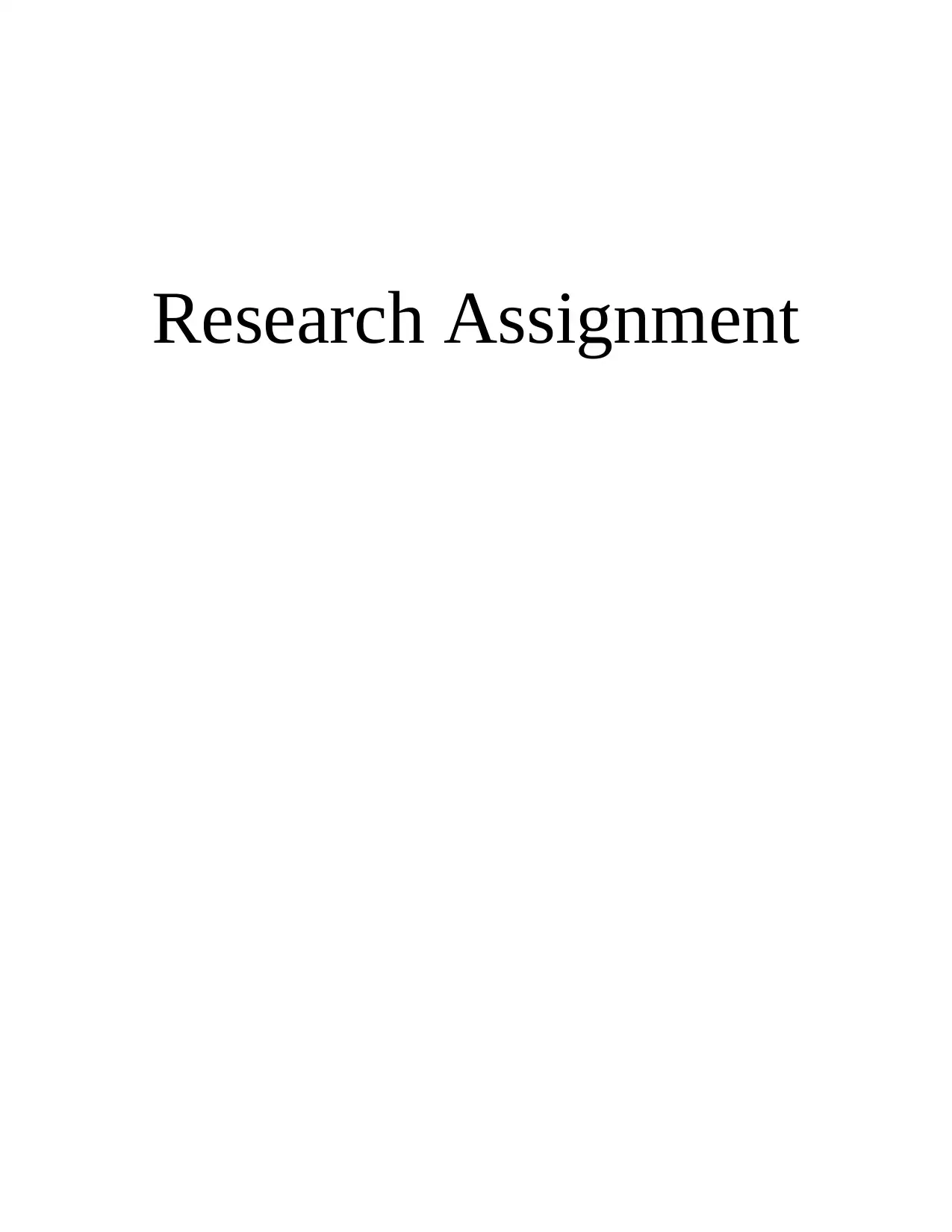
Research Assignment
Paraphrase This Document
Need a fresh take? Get an instant paraphrase of this document with our AI Paraphraser
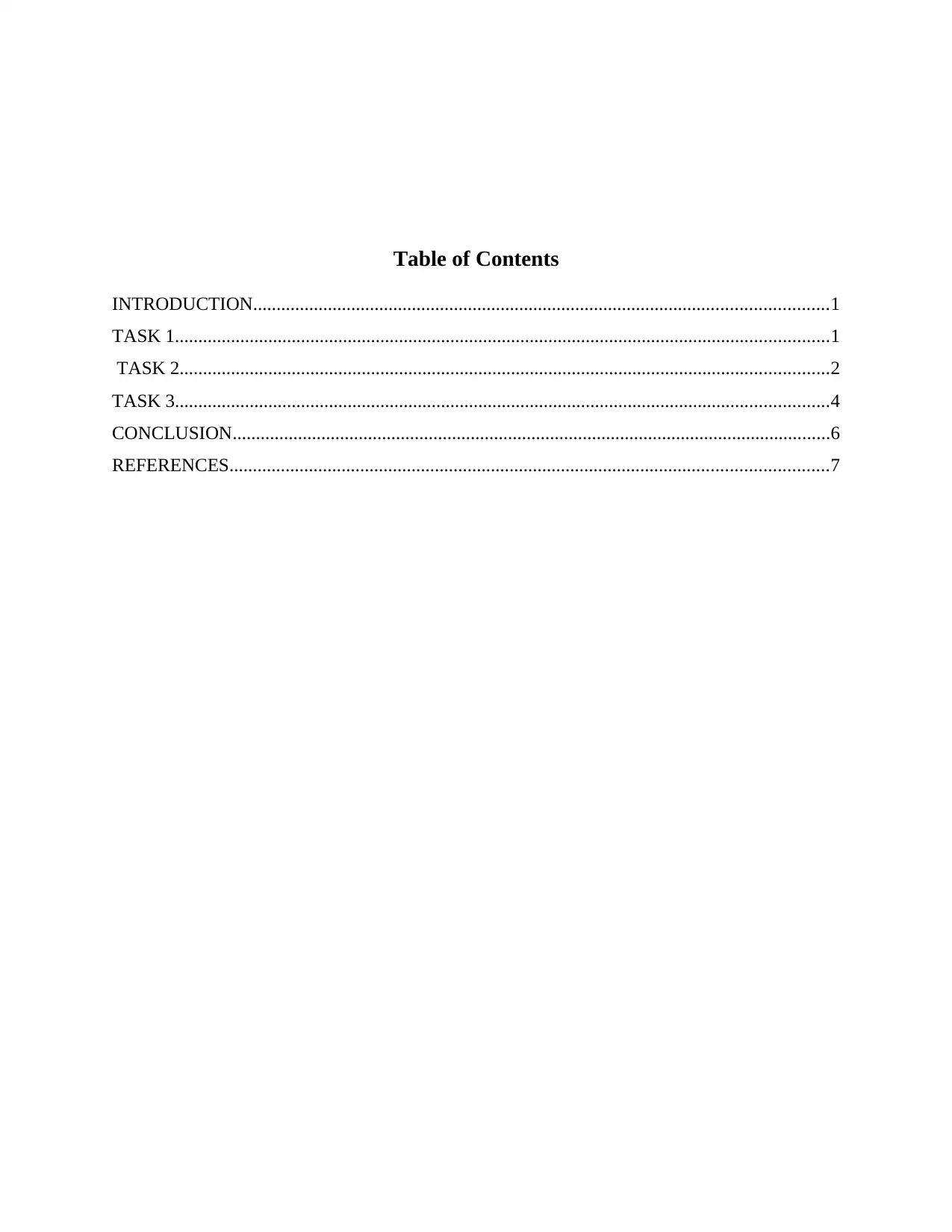
Table of Contents
INTRODUCTION...........................................................................................................................1
TASK 1............................................................................................................................................1
TASK 2...........................................................................................................................................2
TASK 3............................................................................................................................................4
CONCLUSION................................................................................................................................6
REFERENCES................................................................................................................................7
INTRODUCTION...........................................................................................................................1
TASK 1............................................................................................................................................1
TASK 2...........................................................................................................................................2
TASK 3............................................................................................................................................4
CONCLUSION................................................................................................................................6
REFERENCES................................................................................................................................7
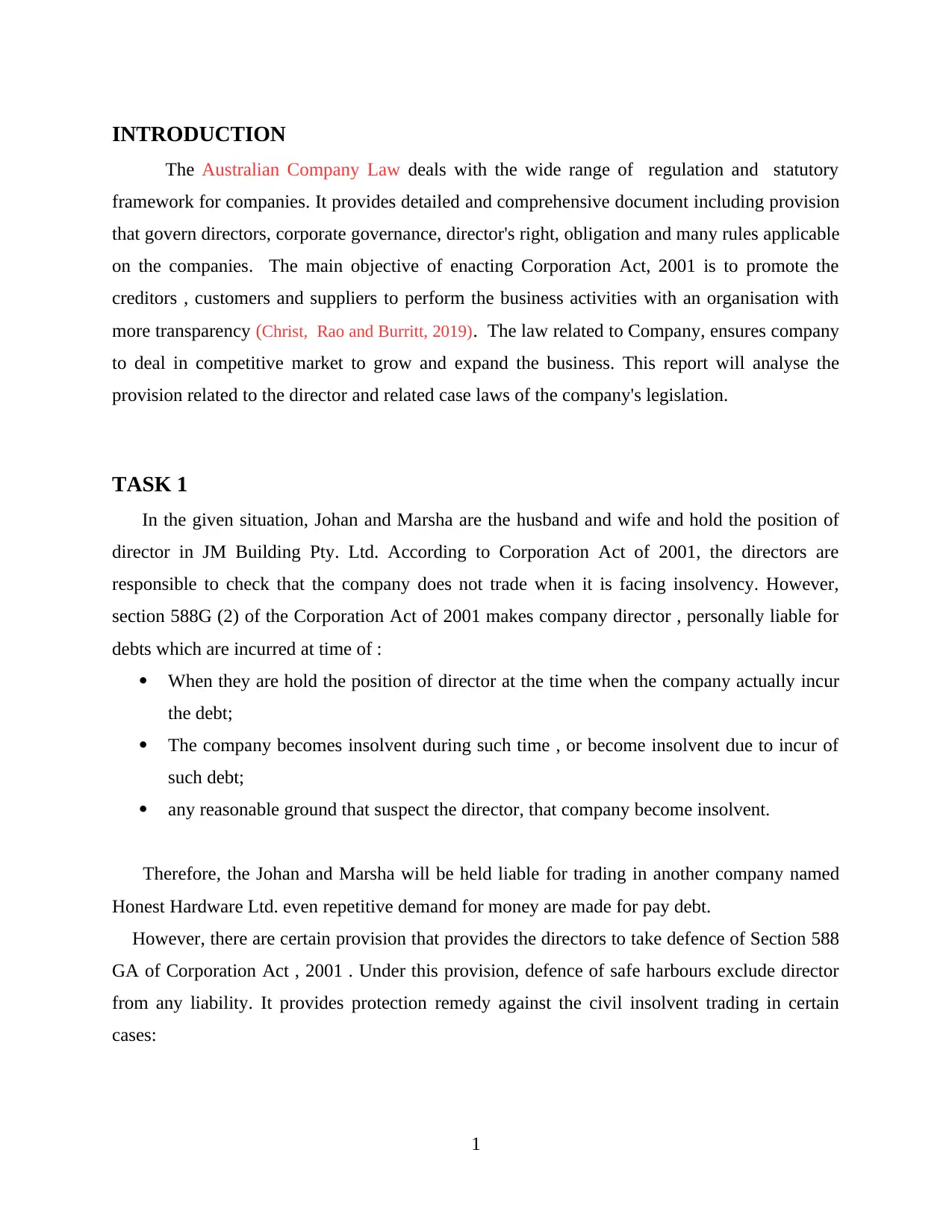
INTRODUCTION
The Australian Company Law deals with the wide range of regulation and statutory
framework for companies. It provides detailed and comprehensive document including provision
that govern directors, corporate governance, director's right, obligation and many rules applicable
on the companies. The main objective of enacting Corporation Act, 2001 is to promote the
creditors , customers and suppliers to perform the business activities with an organisation with
more transparency (Christ, Rao and Burritt, 2019). The law related to Company, ensures company
to deal in competitive market to grow and expand the business. This report will analyse the
provision related to the director and related case laws of the company's legislation.
TASK 1
In the given situation, Johan and Marsha are the husband and wife and hold the position of
director in JM Building Pty. Ltd. According to Corporation Act of 2001, the directors are
responsible to check that the company does not trade when it is facing insolvency. However,
section 588G (2) of the Corporation Act of 2001 makes company director , personally liable for
debts which are incurred at time of :
When they are hold the position of director at the time when the company actually incur
the debt;
The company becomes insolvent during such time , or become insolvent due to incur of
such debt;
any reasonable ground that suspect the director, that company become insolvent.
Therefore, the Johan and Marsha will be held liable for trading in another company named
Honest Hardware Ltd. even repetitive demand for money are made for pay debt.
However, there are certain provision that provides the directors to take defence of Section 588
GA of Corporation Act , 2001 . Under this provision, defence of safe harbours exclude director
from any liability. It provides protection remedy against the civil insolvent trading in certain
cases:
1
The Australian Company Law deals with the wide range of regulation and statutory
framework for companies. It provides detailed and comprehensive document including provision
that govern directors, corporate governance, director's right, obligation and many rules applicable
on the companies. The main objective of enacting Corporation Act, 2001 is to promote the
creditors , customers and suppliers to perform the business activities with an organisation with
more transparency (Christ, Rao and Burritt, 2019). The law related to Company, ensures company
to deal in competitive market to grow and expand the business. This report will analyse the
provision related to the director and related case laws of the company's legislation.
TASK 1
In the given situation, Johan and Marsha are the husband and wife and hold the position of
director in JM Building Pty. Ltd. According to Corporation Act of 2001, the directors are
responsible to check that the company does not trade when it is facing insolvency. However,
section 588G (2) of the Corporation Act of 2001 makes company director , personally liable for
debts which are incurred at time of :
When they are hold the position of director at the time when the company actually incur
the debt;
The company becomes insolvent during such time , or become insolvent due to incur of
such debt;
any reasonable ground that suspect the director, that company become insolvent.
Therefore, the Johan and Marsha will be held liable for trading in another company named
Honest Hardware Ltd. even repetitive demand for money are made for pay debt.
However, there are certain provision that provides the directors to take defence of Section 588
GA of Corporation Act , 2001 . Under this provision, defence of safe harbours exclude director
from any liability. It provides protection remedy against the civil insolvent trading in certain
cases:
1
⊘ This is a preview!⊘
Do you want full access?
Subscribe today to unlock all pages.

Trusted by 1+ million students worldwide
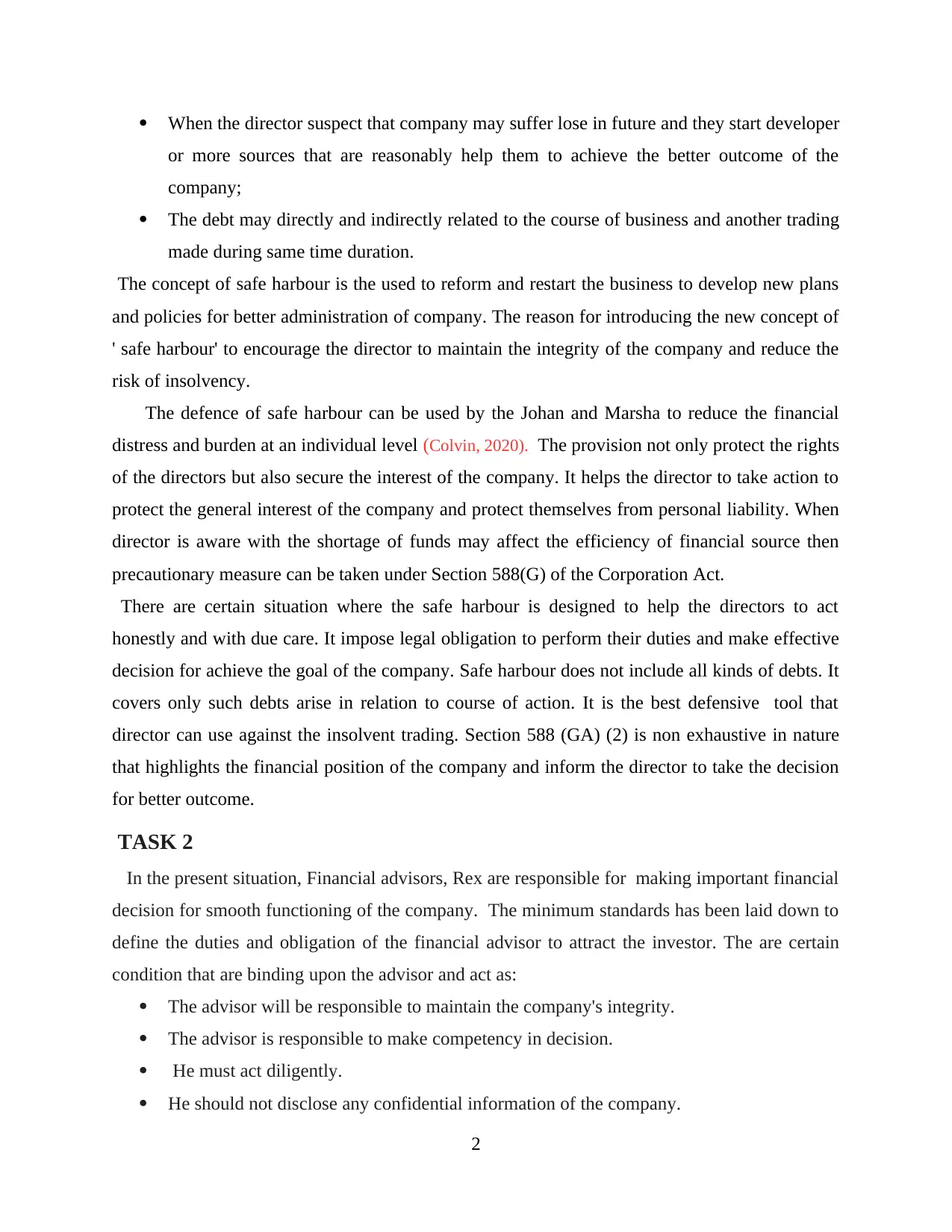
When the director suspect that company may suffer lose in future and they start developer
or more sources that are reasonably help them to achieve the better outcome of the
company;
The debt may directly and indirectly related to the course of business and another trading
made during same time duration.
The concept of safe harbour is the used to reform and restart the business to develop new plans
and policies for better administration of company. The reason for introducing the new concept of
' safe harbour' to encourage the director to maintain the integrity of the company and reduce the
risk of insolvency.
The defence of safe harbour can be used by the Johan and Marsha to reduce the financial
distress and burden at an individual level (Colvin, 2020). The provision not only protect the rights
of the directors but also secure the interest of the company. It helps the director to take action to
protect the general interest of the company and protect themselves from personal liability. When
director is aware with the shortage of funds may affect the efficiency of financial source then
precautionary measure can be taken under Section 588(G) of the Corporation Act.
There are certain situation where the safe harbour is designed to help the directors to act
honestly and with due care. It impose legal obligation to perform their duties and make effective
decision for achieve the goal of the company. Safe harbour does not include all kinds of debts. It
covers only such debts arise in relation to course of action. It is the best defensive tool that
director can use against the insolvent trading. Section 588 (GA) (2) is non exhaustive in nature
that highlights the financial position of the company and inform the director to take the decision
for better outcome.
TASK 2
In the present situation, Financial advisors, Rex are responsible for making important financial
decision for smooth functioning of the company. The minimum standards has been laid down to
define the duties and obligation of the financial advisor to attract the investor. The are certain
condition that are binding upon the advisor and act as:
The advisor will be responsible to maintain the company's integrity.
The advisor is responsible to make competency in decision.
He must act diligently.
He should not disclose any confidential information of the company.
2
or more sources that are reasonably help them to achieve the better outcome of the
company;
The debt may directly and indirectly related to the course of business and another trading
made during same time duration.
The concept of safe harbour is the used to reform and restart the business to develop new plans
and policies for better administration of company. The reason for introducing the new concept of
' safe harbour' to encourage the director to maintain the integrity of the company and reduce the
risk of insolvency.
The defence of safe harbour can be used by the Johan and Marsha to reduce the financial
distress and burden at an individual level (Colvin, 2020). The provision not only protect the rights
of the directors but also secure the interest of the company. It helps the director to take action to
protect the general interest of the company and protect themselves from personal liability. When
director is aware with the shortage of funds may affect the efficiency of financial source then
precautionary measure can be taken under Section 588(G) of the Corporation Act.
There are certain situation where the safe harbour is designed to help the directors to act
honestly and with due care. It impose legal obligation to perform their duties and make effective
decision for achieve the goal of the company. Safe harbour does not include all kinds of debts. It
covers only such debts arise in relation to course of action. It is the best defensive tool that
director can use against the insolvent trading. Section 588 (GA) (2) is non exhaustive in nature
that highlights the financial position of the company and inform the director to take the decision
for better outcome.
TASK 2
In the present situation, Financial advisors, Rex are responsible for making important financial
decision for smooth functioning of the company. The minimum standards has been laid down to
define the duties and obligation of the financial advisor to attract the investor. The are certain
condition that are binding upon the advisor and act as:
The advisor will be responsible to maintain the company's integrity.
The advisor is responsible to make competency in decision.
He must act diligently.
He should not disclose any confidential information of the company.
2
Paraphrase This Document
Need a fresh take? Get an instant paraphrase of this document with our AI Paraphraser
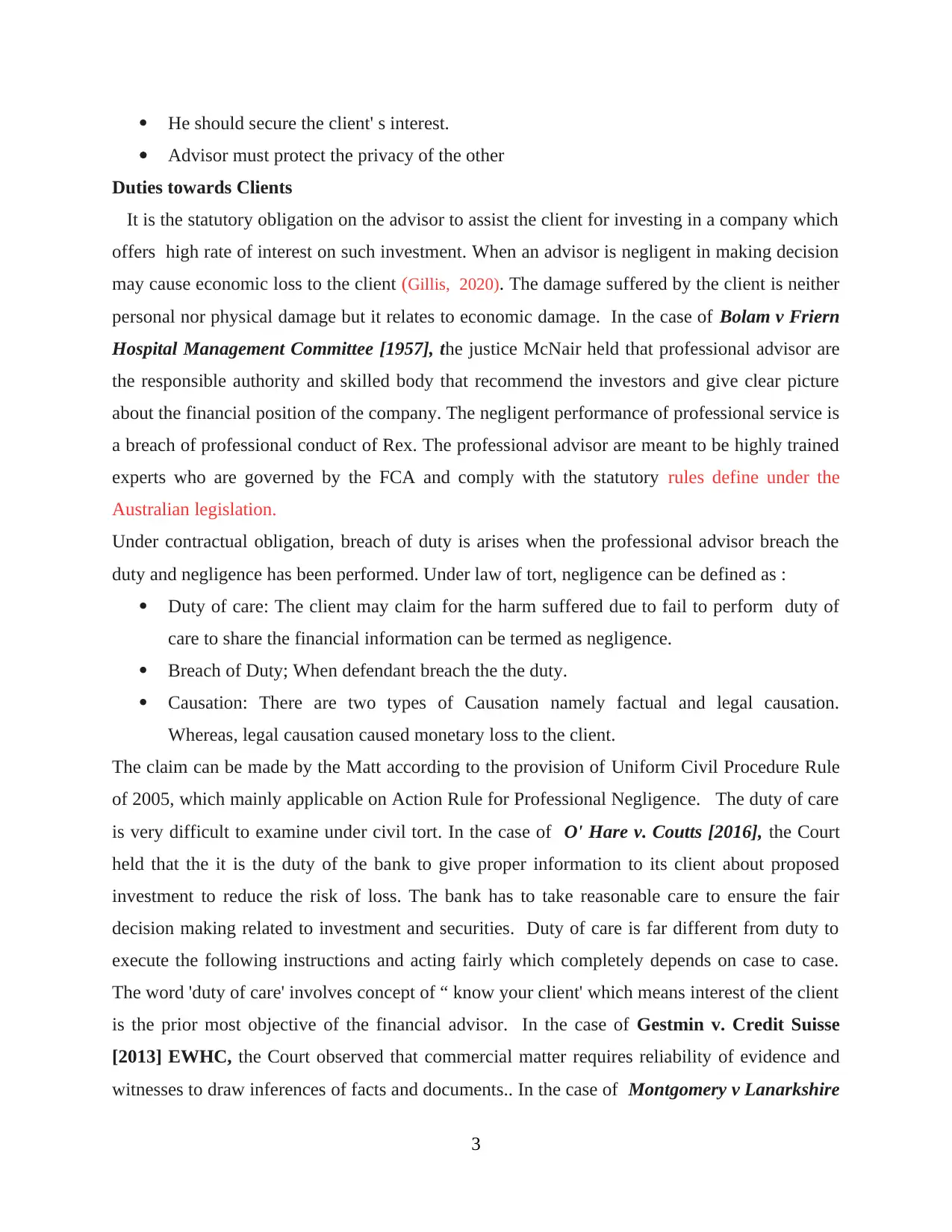
He should secure the client' s interest.
Advisor must protect the privacy of the other
Duties towards Clients
It is the statutory obligation on the advisor to assist the client for investing in a company which
offers high rate of interest on such investment. When an advisor is negligent in making decision
may cause economic loss to the client (Gillis, 2020). The damage suffered by the client is neither
personal nor physical damage but it relates to economic damage. In the case of Bolam v Friern
Hospital Management Committee [1957], the justice McNair held that professional advisor are
the responsible authority and skilled body that recommend the investors and give clear picture
about the financial position of the company. The negligent performance of professional service is
a breach of professional conduct of Rex. The professional advisor are meant to be highly trained
experts who are governed by the FCA and comply with the statutory rules define under the
Australian legislation.
Under contractual obligation, breach of duty is arises when the professional advisor breach the
duty and negligence has been performed. Under law of tort, negligence can be defined as :
Duty of care: The client may claim for the harm suffered due to fail to perform duty of
care to share the financial information can be termed as negligence.
Breach of Duty; When defendant breach the the duty.
Causation: There are two types of Causation namely factual and legal causation.
Whereas, legal causation caused monetary loss to the client.
The claim can be made by the Matt according to the provision of Uniform Civil Procedure Rule
of 2005, which mainly applicable on Action Rule for Professional Negligence. The duty of care
is very difficult to examine under civil tort. In the case of O' Hare v. Coutts [2016], the Court
held that the it is the duty of the bank to give proper information to its client about proposed
investment to reduce the risk of loss. The bank has to take reasonable care to ensure the fair
decision making related to investment and securities. Duty of care is far different from duty to
execute the following instructions and acting fairly which completely depends on case to case.
The word 'duty of care' involves concept of “ know your client' which means interest of the client
is the prior most objective of the financial advisor. In the case of Gestmin v. Credit Suisse
[2013] EWHC, the Court observed that commercial matter requires reliability of evidence and
witnesses to draw inferences of facts and documents.. In the case of Montgomery v Lanarkshire
3
Advisor must protect the privacy of the other
Duties towards Clients
It is the statutory obligation on the advisor to assist the client for investing in a company which
offers high rate of interest on such investment. When an advisor is negligent in making decision
may cause economic loss to the client (Gillis, 2020). The damage suffered by the client is neither
personal nor physical damage but it relates to economic damage. In the case of Bolam v Friern
Hospital Management Committee [1957], the justice McNair held that professional advisor are
the responsible authority and skilled body that recommend the investors and give clear picture
about the financial position of the company. The negligent performance of professional service is
a breach of professional conduct of Rex. The professional advisor are meant to be highly trained
experts who are governed by the FCA and comply with the statutory rules define under the
Australian legislation.
Under contractual obligation, breach of duty is arises when the professional advisor breach the
duty and negligence has been performed. Under law of tort, negligence can be defined as :
Duty of care: The client may claim for the harm suffered due to fail to perform duty of
care to share the financial information can be termed as negligence.
Breach of Duty; When defendant breach the the duty.
Causation: There are two types of Causation namely factual and legal causation.
Whereas, legal causation caused monetary loss to the client.
The claim can be made by the Matt according to the provision of Uniform Civil Procedure Rule
of 2005, which mainly applicable on Action Rule for Professional Negligence. The duty of care
is very difficult to examine under civil tort. In the case of O' Hare v. Coutts [2016], the Court
held that the it is the duty of the bank to give proper information to its client about proposed
investment to reduce the risk of loss. The bank has to take reasonable care to ensure the fair
decision making related to investment and securities. Duty of care is far different from duty to
execute the following instructions and acting fairly which completely depends on case to case.
The word 'duty of care' involves concept of “ know your client' which means interest of the client
is the prior most objective of the financial advisor. In the case of Gestmin v. Credit Suisse
[2013] EWHC, the Court observed that commercial matter requires reliability of evidence and
witnesses to draw inferences of facts and documents.. In the case of Montgomery v Lanarkshire
3
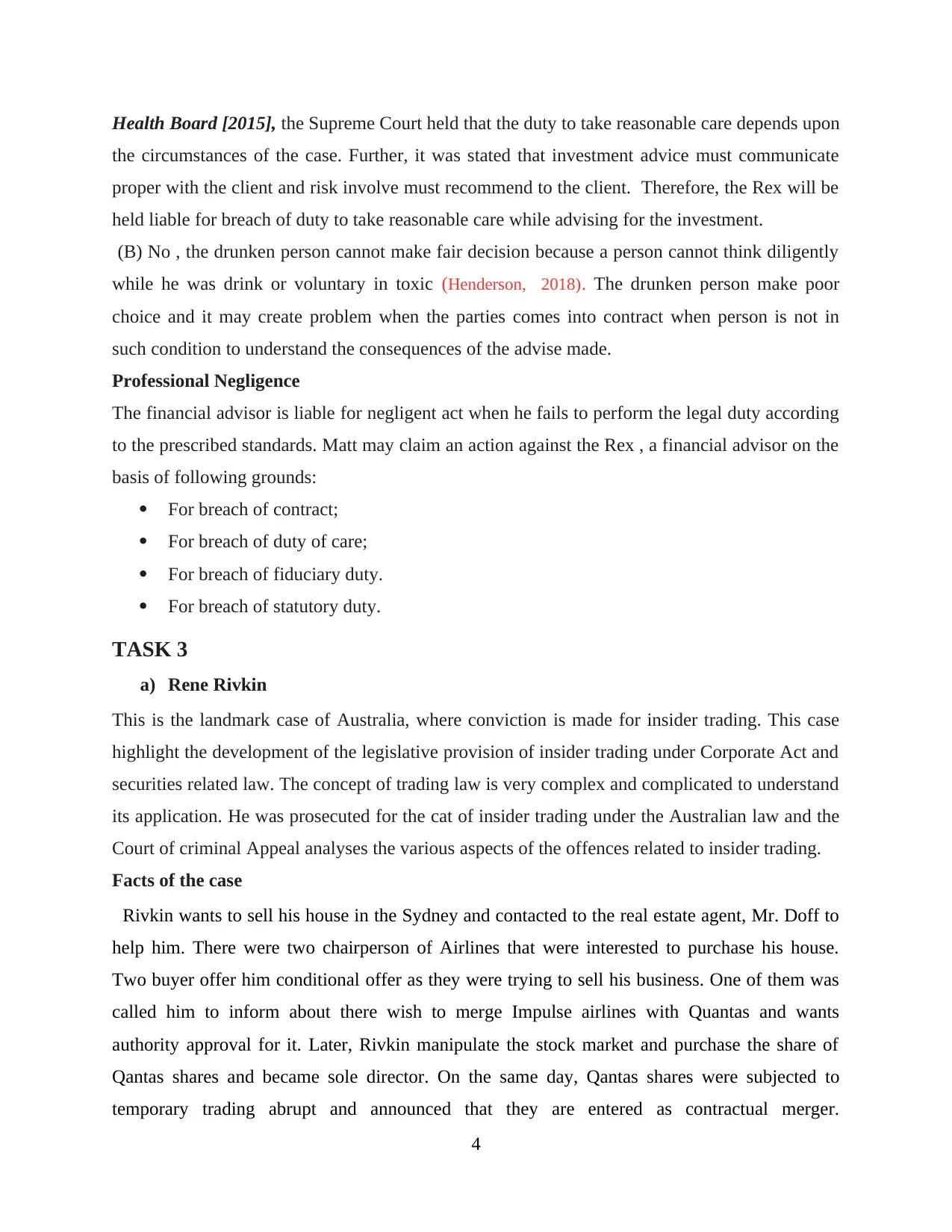
Health Board [2015], the Supreme Court held that the duty to take reasonable care depends upon
the circumstances of the case. Further, it was stated that investment advice must communicate
proper with the client and risk involve must recommend to the client. Therefore, the Rex will be
held liable for breach of duty to take reasonable care while advising for the investment.
(B) No , the drunken person cannot make fair decision because a person cannot think diligently
while he was drink or voluntary in toxic (Henderson, 2018). The drunken person make poor
choice and it may create problem when the parties comes into contract when person is not in
such condition to understand the consequences of the advise made.
Professional Negligence
The financial advisor is liable for negligent act when he fails to perform the legal duty according
to the prescribed standards. Matt may claim an action against the Rex , a financial advisor on the
basis of following grounds:
For breach of contract;
For breach of duty of care;
For breach of fiduciary duty.
For breach of statutory duty.
TASK 3
a) Rene Rivkin
This is the landmark case of Australia, where conviction is made for insider trading. This case
highlight the development of the legislative provision of insider trading under Corporate Act and
securities related law. The concept of trading law is very complex and complicated to understand
its application. He was prosecuted for the cat of insider trading under the Australian law and the
Court of criminal Appeal analyses the various aspects of the offences related to insider trading.
Facts of the case
Rivkin wants to sell his house in the Sydney and contacted to the real estate agent, Mr. Doff to
help him. There were two chairperson of Airlines that were interested to purchase his house.
Two buyer offer him conditional offer as they were trying to sell his business. One of them was
called him to inform about there wish to merge Impulse airlines with Quantas and wants
authority approval for it. Later, Rivkin manipulate the stock market and purchase the share of
Qantas shares and became sole director. On the same day, Qantas shares were subjected to
temporary trading abrupt and announced that they are entered as contractual merger.
4
the circumstances of the case. Further, it was stated that investment advice must communicate
proper with the client and risk involve must recommend to the client. Therefore, the Rex will be
held liable for breach of duty to take reasonable care while advising for the investment.
(B) No , the drunken person cannot make fair decision because a person cannot think diligently
while he was drink or voluntary in toxic (Henderson, 2018). The drunken person make poor
choice and it may create problem when the parties comes into contract when person is not in
such condition to understand the consequences of the advise made.
Professional Negligence
The financial advisor is liable for negligent act when he fails to perform the legal duty according
to the prescribed standards. Matt may claim an action against the Rex , a financial advisor on the
basis of following grounds:
For breach of contract;
For breach of duty of care;
For breach of fiduciary duty.
For breach of statutory duty.
TASK 3
a) Rene Rivkin
This is the landmark case of Australia, where conviction is made for insider trading. This case
highlight the development of the legislative provision of insider trading under Corporate Act and
securities related law. The concept of trading law is very complex and complicated to understand
its application. He was prosecuted for the cat of insider trading under the Australian law and the
Court of criminal Appeal analyses the various aspects of the offences related to insider trading.
Facts of the case
Rivkin wants to sell his house in the Sydney and contacted to the real estate agent, Mr. Doff to
help him. There were two chairperson of Airlines that were interested to purchase his house.
Two buyer offer him conditional offer as they were trying to sell his business. One of them was
called him to inform about there wish to merge Impulse airlines with Quantas and wants
authority approval for it. Later, Rivkin manipulate the stock market and purchase the share of
Qantas shares and became sole director. On the same day, Qantas shares were subjected to
temporary trading abrupt and announced that they are entered as contractual merger.
4
⊘ This is a preview!⊘
Do you want full access?
Subscribe today to unlock all pages.

Trusted by 1+ million students worldwide
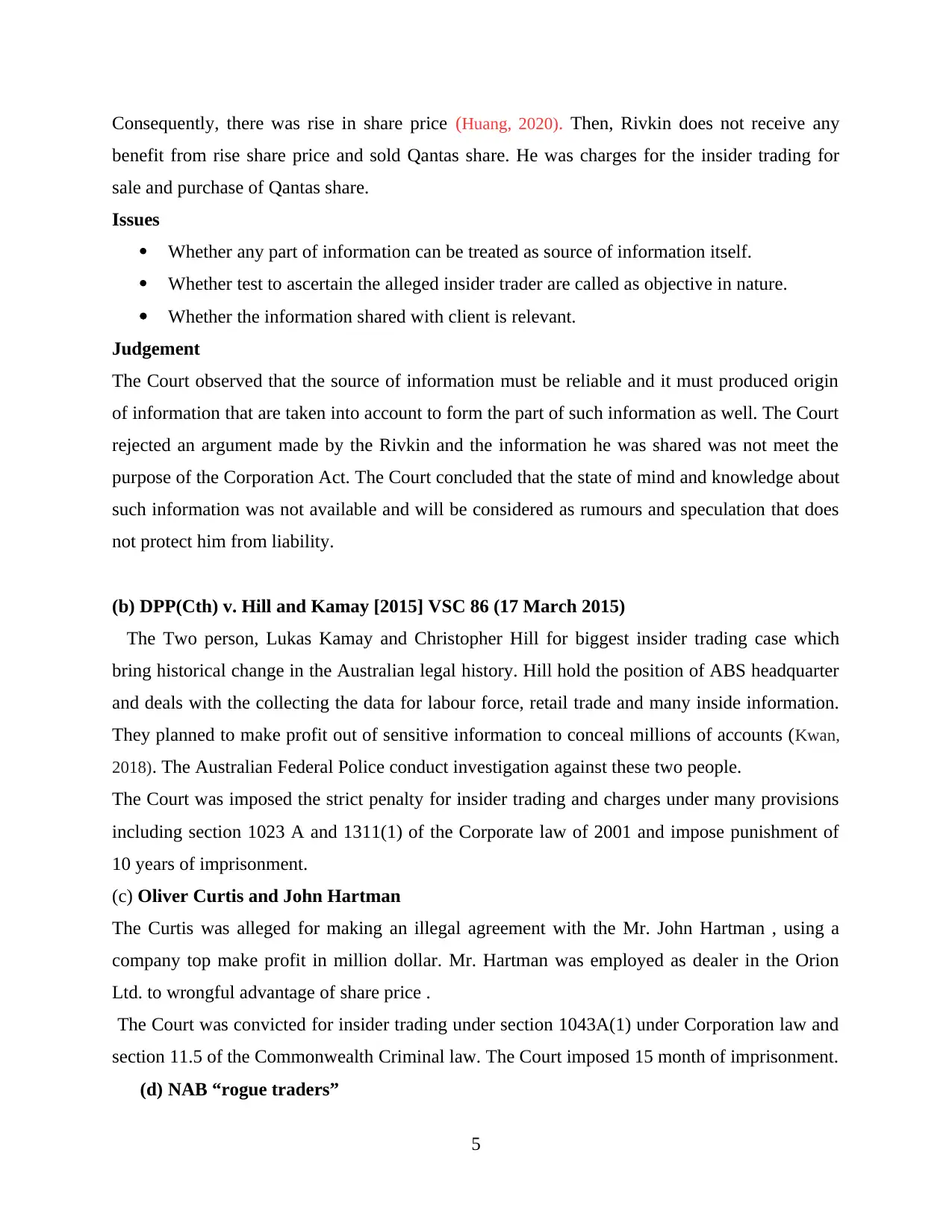
Consequently, there was rise in share price (Huang, 2020). Then, Rivkin does not receive any
benefit from rise share price and sold Qantas share. He was charges for the insider trading for
sale and purchase of Qantas share.
Issues
Whether any part of information can be treated as source of information itself.
Whether test to ascertain the alleged insider trader are called as objective in nature.
Whether the information shared with client is relevant.
Judgement
The Court observed that the source of information must be reliable and it must produced origin
of information that are taken into account to form the part of such information as well. The Court
rejected an argument made by the Rivkin and the information he was shared was not meet the
purpose of the Corporation Act. The Court concluded that the state of mind and knowledge about
such information was not available and will be considered as rumours and speculation that does
not protect him from liability.
(b) DPP(Cth) v. Hill and Kamay [2015] VSC 86 (17 March 2015)
The Two person, Lukas Kamay and Christopher Hill for biggest insider trading case which
bring historical change in the Australian legal history. Hill hold the position of ABS headquarter
and deals with the collecting the data for labour force, retail trade and many inside information.
They planned to make profit out of sensitive information to conceal millions of accounts (Kwan,
2018). The Australian Federal Police conduct investigation against these two people.
The Court was imposed the strict penalty for insider trading and charges under many provisions
including section 1023 A and 1311(1) of the Corporate law of 2001 and impose punishment of
10 years of imprisonment.
(c) Oliver Curtis and John Hartman
The Curtis was alleged for making an illegal agreement with the Mr. John Hartman , using a
company top make profit in million dollar. Mr. Hartman was employed as dealer in the Orion
Ltd. to wrongful advantage of share price .
The Court was convicted for insider trading under section 1043A(1) under Corporation law and
section 11.5 of the Commonwealth Criminal law. The Court imposed 15 month of imprisonment.
(d) NAB “rogue traders”
5
benefit from rise share price and sold Qantas share. He was charges for the insider trading for
sale and purchase of Qantas share.
Issues
Whether any part of information can be treated as source of information itself.
Whether test to ascertain the alleged insider trader are called as objective in nature.
Whether the information shared with client is relevant.
Judgement
The Court observed that the source of information must be reliable and it must produced origin
of information that are taken into account to form the part of such information as well. The Court
rejected an argument made by the Rivkin and the information he was shared was not meet the
purpose of the Corporation Act. The Court concluded that the state of mind and knowledge about
such information was not available and will be considered as rumours and speculation that does
not protect him from liability.
(b) DPP(Cth) v. Hill and Kamay [2015] VSC 86 (17 March 2015)
The Two person, Lukas Kamay and Christopher Hill for biggest insider trading case which
bring historical change in the Australian legal history. Hill hold the position of ABS headquarter
and deals with the collecting the data for labour force, retail trade and many inside information.
They planned to make profit out of sensitive information to conceal millions of accounts (Kwan,
2018). The Australian Federal Police conduct investigation against these two people.
The Court was imposed the strict penalty for insider trading and charges under many provisions
including section 1023 A and 1311(1) of the Corporate law of 2001 and impose punishment of
10 years of imprisonment.
(c) Oliver Curtis and John Hartman
The Curtis was alleged for making an illegal agreement with the Mr. John Hartman , using a
company top make profit in million dollar. Mr. Hartman was employed as dealer in the Orion
Ltd. to wrongful advantage of share price .
The Court was convicted for insider trading under section 1043A(1) under Corporation law and
section 11.5 of the Commonwealth Criminal law. The Court imposed 15 month of imprisonment.
(d) NAB “rogue traders”
5
Paraphrase This Document
Need a fresh take? Get an instant paraphrase of this document with our AI Paraphraser
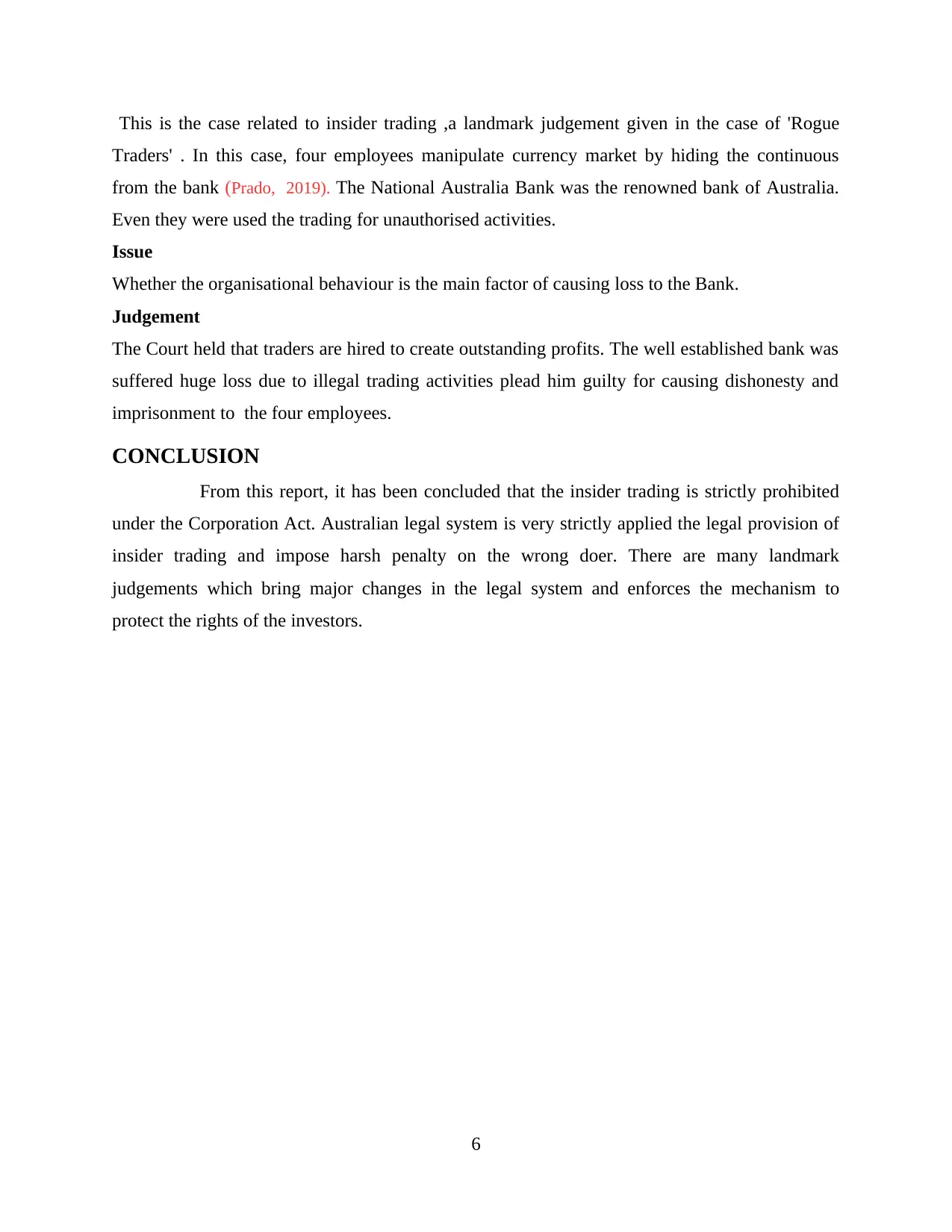
This is the case related to insider trading ,a landmark judgement given in the case of 'Rogue
Traders' . In this case, four employees manipulate currency market by hiding the continuous
from the bank (Prado, 2019). The National Australia Bank was the renowned bank of Australia.
Even they were used the trading for unauthorised activities.
Issue
Whether the organisational behaviour is the main factor of causing loss to the Bank.
Judgement
The Court held that traders are hired to create outstanding profits. The well established bank was
suffered huge loss due to illegal trading activities plead him guilty for causing dishonesty and
imprisonment to the four employees.
CONCLUSION
From this report, it has been concluded that the insider trading is strictly prohibited
under the Corporation Act. Australian legal system is very strictly applied the legal provision of
insider trading and impose harsh penalty on the wrong doer. There are many landmark
judgements which bring major changes in the legal system and enforces the mechanism to
protect the rights of the investors.
6
Traders' . In this case, four employees manipulate currency market by hiding the continuous
from the bank (Prado, 2019). The National Australia Bank was the renowned bank of Australia.
Even they were used the trading for unauthorised activities.
Issue
Whether the organisational behaviour is the main factor of causing loss to the Bank.
Judgement
The Court held that traders are hired to create outstanding profits. The well established bank was
suffered huge loss due to illegal trading activities plead him guilty for causing dishonesty and
imprisonment to the four employees.
CONCLUSION
From this report, it has been concluded that the insider trading is strictly prohibited
under the Corporation Act. Australian legal system is very strictly applied the legal provision of
insider trading and impose harsh penalty on the wrong doer. There are many landmark
judgements which bring major changes in the legal system and enforces the mechanism to
protect the rights of the investors.
6
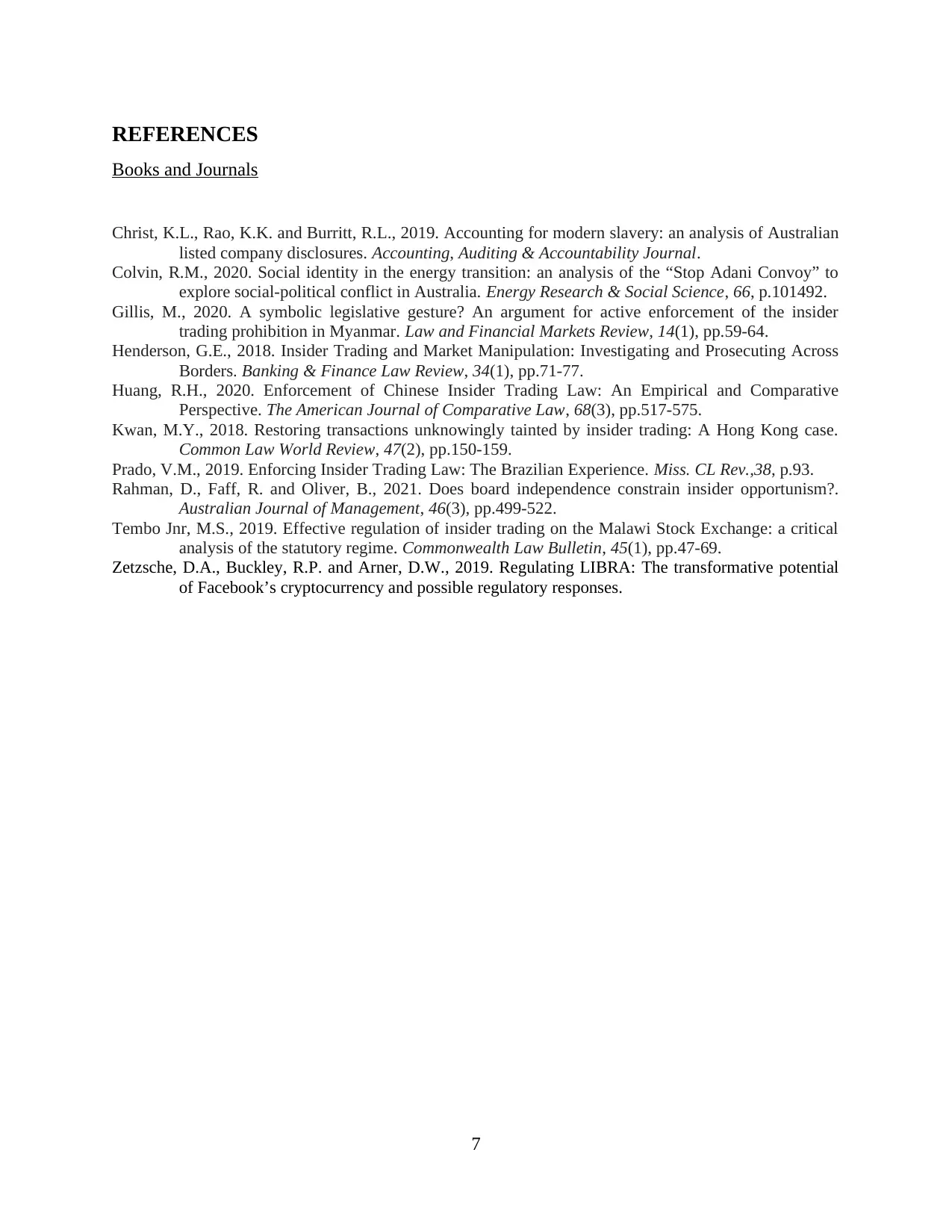
REFERENCES
Books and Journals
Christ, K.L., Rao, K.K. and Burritt, R.L., 2019. Accounting for modern slavery: an analysis of Australian
listed company disclosures. Accounting, Auditing & Accountability Journal.
Colvin, R.M., 2020. Social identity in the energy transition: an analysis of the “Stop Adani Convoy” to
explore social-political conflict in Australia. Energy Research & Social Science, 66, p.101492.
Gillis, M., 2020. A symbolic legislative gesture? An argument for active enforcement of the insider
trading prohibition in Myanmar. Law and Financial Markets Review, 14(1), pp.59-64.
Henderson, G.E., 2018. Insider Trading and Market Manipulation: Investigating and Prosecuting Across
Borders. Banking & Finance Law Review, 34(1), pp.71-77.
Huang, R.H., 2020. Enforcement of Chinese Insider Trading Law: An Empirical and Comparative
Perspective. The American Journal of Comparative Law, 68(3), pp.517-575.
Kwan, M.Y., 2018. Restoring transactions unknowingly tainted by insider trading: A Hong Kong case.
Common Law World Review, 47(2), pp.150-159.
Prado, V.M., 2019. Enforcing Insider Trading Law: The Brazilian Experience. Miss. CL Rev.,38, p.93.
Rahman, D., Faff, R. and Oliver, B., 2021. Does board independence constrain insider opportunism?.
Australian Journal of Management, 46(3), pp.499-522.
Tembo Jnr, M.S., 2019. Effective regulation of insider trading on the Malawi Stock Exchange: a critical
analysis of the statutory regime. Commonwealth Law Bulletin, 45(1), pp.47-69.
Zetzsche, D.A., Buckley, R.P. and Arner, D.W., 2019. Regulating LIBRA: The transformative potential
of Facebook’s cryptocurrency and possible regulatory responses.
7
Books and Journals
Christ, K.L., Rao, K.K. and Burritt, R.L., 2019. Accounting for modern slavery: an analysis of Australian
listed company disclosures. Accounting, Auditing & Accountability Journal.
Colvin, R.M., 2020. Social identity in the energy transition: an analysis of the “Stop Adani Convoy” to
explore social-political conflict in Australia. Energy Research & Social Science, 66, p.101492.
Gillis, M., 2020. A symbolic legislative gesture? An argument for active enforcement of the insider
trading prohibition in Myanmar. Law and Financial Markets Review, 14(1), pp.59-64.
Henderson, G.E., 2018. Insider Trading and Market Manipulation: Investigating and Prosecuting Across
Borders. Banking & Finance Law Review, 34(1), pp.71-77.
Huang, R.H., 2020. Enforcement of Chinese Insider Trading Law: An Empirical and Comparative
Perspective. The American Journal of Comparative Law, 68(3), pp.517-575.
Kwan, M.Y., 2018. Restoring transactions unknowingly tainted by insider trading: A Hong Kong case.
Common Law World Review, 47(2), pp.150-159.
Prado, V.M., 2019. Enforcing Insider Trading Law: The Brazilian Experience. Miss. CL Rev.,38, p.93.
Rahman, D., Faff, R. and Oliver, B., 2021. Does board independence constrain insider opportunism?.
Australian Journal of Management, 46(3), pp.499-522.
Tembo Jnr, M.S., 2019. Effective regulation of insider trading on the Malawi Stock Exchange: a critical
analysis of the statutory regime. Commonwealth Law Bulletin, 45(1), pp.47-69.
Zetzsche, D.A., Buckley, R.P. and Arner, D.W., 2019. Regulating LIBRA: The transformative potential
of Facebook’s cryptocurrency and possible regulatory responses.
7
⊘ This is a preview!⊘
Do you want full access?
Subscribe today to unlock all pages.

Trusted by 1+ million students worldwide
1 out of 9
Related Documents
Your All-in-One AI-Powered Toolkit for Academic Success.
+13062052269
info@desklib.com
Available 24*7 on WhatsApp / Email
![[object Object]](/_next/static/media/star-bottom.7253800d.svg)
Unlock your academic potential
Copyright © 2020–2025 A2Z Services. All Rights Reserved. Developed and managed by ZUCOL.





